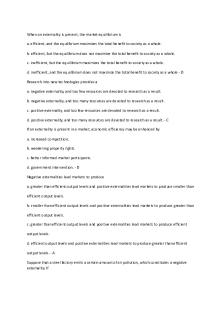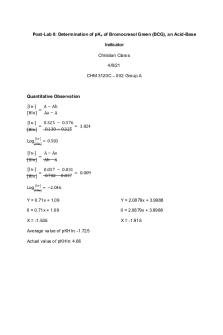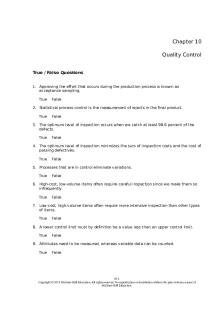2111 Chap 10 Bromocresol Green 0817 PDF

| Title | 2111 Chap 10 Bromocresol Green 0817 |
|---|---|
| Author | Hien Pham |
| Course | Introductory Analytical Chemistry Lab |
| Institution | University of Minnesota, Twin Cities |
| Pages | 14 |
| File Size | 962 KB |
| File Type | |
| Total Downloads | 108 |
| Total Views | 171 |
Summary
Download 2111 Chap 10 Bromocresol Green 0817 PDF
Description
Revised by Laura MacManus-Spencer 8/03, Anne Boreen 12/04, R. Machado 8/05, P. Buhlmann 7/06, 5-07
Chapter X Experiment #7 A Study of the pKa of Bromocresol Green (BCG) 11.1
Introduction Goals: (1) Prepare a series of buffered BCG solutions, and measure and calculate the pH of these solutions. (2) Utilize absorption spectrophotometry and pH measurements to calculate the indicator constant, KIN , of BCG. (3) Understand the concept of activity and identify the factors that affect the activity of an ion in solution.
In this experiment, we will determine the indicator constant, KIN, of bromocresol green (BCG), a common indicator dye used in titrations. From the KIN values, we will determine the pH transition interval over which BCG changes from its basic to acidic form and show how an indicator can be used to measure pH.
(a) Definition of pH It is important to keep in mind the rigorous definition of pH, which is pH = - log(aH 3O+ )
where aH3O+ is called the activity of the hydronium ion. The activity of a species X is defined as follows:
a X = g X [X] where [X] and gX are the concentration and activity coefficient of X, respectively. When we write
[ ]
pH = -log H +
we are making the assumption that the activity coefficient of H3O+ is equal to 1. Under most conditions, this assumption is allowable, but for this experiment we must be more rigorous and focus on activities as well as concentrations.
X-1
Revised by Laura MacManus-Spencer 8/03, Anne Boreen 12/04, R. Machado 8/05, P. Buhlmann 7/06, 5-07
Furthermore, we have become accustomed to writing H+ instead of H3O+. Writing H3O+ is actually more correct since single protons are not found in water. H+ in an aqueous system is only found bound to water to form H3O+: H
+
O H
O+
H+
H
H
H
(b) Bromocresol green and the derivation of the indicator constant, KIN Bromocresol green (3', 3", 5', 5"-tetrabromo-m-cresolsulfonphthalein) is a commonly used indicator for acid-base titrations. The indicator is the sodium salt of a sulfonic acid that we will designate as NaHX. The full structure of NaHX is: Br
Sulfonic acids are very strong acids, so we may
OH
disregard the weak basicity of the SO3- group. When Br
Br
CH3
CH3 SO3 -
O
bromocresol green functions as an indicator, it is a second acidic dissociation that is involved. The proton Na+
that ionizes is indicated by the arrow. The resulting basic form, a dianion, cannot be represented by a single
Br
structure, but is a resonance hybrid of a number of structures such as:
Br
Br
CH3
O-
Br
Br
Br
CH3 SO3 -
O
CH3
Br CH3 SO3-
-O
Br
O
Br
Taking our abbreviation for the acid form, HX-, the equilibrium of interest is: -
HX- + H2O « X 2 + H3O+ yellow blue
X-2
(11.1)
Revised by Laura MacManus-Spencer 8/03, Anne Boreen 12/04, R. Machado 8/05, P. Buhlmann 7/06, 5-07
Recalling the definition of activity above and taking activity into account, the equilibrium constant for the above reaction is
a KA = KIN =
H3 O+
a
•a
HX -
X 2-
• g 2g X [H3O+ ][X 2 - ] H3O + • = g HX [HX ]
æ [X2-] ö ø è
æ KIN = (aH3O+) • ç [HX-]÷ • ç
g 2- ö X ÷ ÷ çg è HX -ø
11.2
The material presented in the following section is based on Beer's law. For a review of Beer's law, see your textbook for CHEM 2101 or consult with the instructor. In this experiment, we are going to determine this equilibrium constant, KIN, by varying the pH, or aH3O+ and measuring the ratio [X2-]/[HX-] using spectrophotometry. The activity coefficients gX2- and gHX- will be calculated using the Davies equation (see calculation section). We will use acetic acid-acetate buffers to control the pH as the KA value for acetic acid is in the same range as the KIN value for bromocresol green. The pH values of these buffers force the bromocresol green to distribute itself somewhat evenly between the two colored forms. The absorption spectra of HX- and X2- are given in Figure 11.1. The HX- ion is yellow because of its absorption of light in the blue region of the spectrum. The X2- ion is blue because of its absorption of light in the red region. At the isosbestic point (525 nm), both species have the same molar absorptivity and the total absorbance of a solution of the two ions is independent of their relative concentrations, but is dependent only upon the total dye concentration. Examination of Fig. 11.1 reveals that several different wavelengths may be used for an analysis of the equilibrium reaction mixture. The best choice, however, is 615 nm where X2absorbs strongly, the HX- absorbance is negligible, and neither the acetate nor acetic acid parts of the buffer absorb.
X-3
Revised by Laura MacManus-Spencer 8/03, Anne Boreen 12/04, R. Machado 8/05, P. Buhlmann 7/06, 5-07
Figure 11.1
The measured absorbance, A, at 615 nm (red region) is the sum of the contributions from the two forms: A = A HX - + A X 2 -
(11.3)
The absorption maximum for X2- is at a much longer wavelength (lower energy electronic transition) than that of HX-. This is related to the delocalization of the electrons of X2- compared to HX-; it results from the resonance in X2-. For the basic solution, all of the BCG is in the X2- form. Thus, by measuring the absorbance of this solution at 615 nm and applying Beer's Law, the total concentration of BCG, CT, can be expressed as
CT = [ X2 - ] =
A basic e 615b
(11.4)
Similarly, for a series of BCG solutions containing the same total concentration of BCG (CT) but different distributions between the basic and acidic forms,
C T = [ X 2- ] + [HX - ]
where
[X 2- ] =
Asample e 615 b
(11.5)
(11.6)
X-4
Revised by Laura MacManus-Spencer 8/03, Anne Boreen 12/04, R. Machado 8/05, P. Buhlmann 7/06, 5-07
Solving for [HX-] and substituting expression (4) in for CT yields
[HX - ] =
Now the ratio of
Abasic A sample e 615 b e 615 b
(11.7)
[ X 2- ] can be evaluated for each sample solution: [HX - ] [X2- ] [HX- ]
Asample ε615 b A basic sample -! ε615 b ε615 b
=! A
=! A
Asample
(11.8)
basic -!Asample
The equilibrium constant, KIN expression, thus becomes
ö æ g 2- ö Asample ö æç æ ÷ç X ÷ KIN = ç a H O + ÷ ç è 3 ø è Abasic - Asample ÷ø çè g - ÷ø
(11.9)
HX
(c) The transition interval of BCG When we used bromocresol green as an indicator dye in the Practice Titration experiment, we saw a color change at the endpoint of the titration of a base with an acid as a result of the change in pH from basic à neutral. There is actually a pH range over which BCG changes from blue à green à yellow as it changes ionic states (from X2- to HX-). We can determine this pH range, called the “transition interval,” from simple pH and absorbance measurements of a series of buffer solutions of BCG. The definition of the transition interval is the pH range over which the log of the ratio of the activity coefficients of X2- to HX- varies from +1 to –1. If we remember that
æ10ö logç ÷ = +1 è1ø
æ1 ö and logç ÷ = -1 è 10 ø
ö æa 2- ÷ ç x we see that the log of the ratio of the activity coefficients of X and HX : log ç ÷ èa HX - ø 2-
X-5
-
Revised by Laura MacManus-Spencer 8/03, Anne Boreen 12/04, R. Machado 8/05, P. Buhlmann 7/06, 5-07
equals +1 when the activity of X2- is ten times that of HX-. That is, BCG exists primarily in its basic form, X2-. We also see that when the ratio is equal to –1, the activity of HX- is ten times that of X2-. That is, BCG exists primarily in its acidic form, X2-. We have already shown (equations 11.6 – 11.8) that
æ X2 - ö Asample ç ÷ ç ÷= ç HX ÷ A basic - Asample è ø
[ ] [ ]
(11.10)
and we can calculate the ratio
g X2gHX using the Davies equation (see calculation (2) below). Therefore, using the definition of activity, 2g 2g 2Asample X 2- = [X ] X X = • • g g a HX - [HX ] Abasic - Asample HX HX -
a
(11.11)
æ a ö ç x2- ÷ By plotting log ç ÷ vs. pH, we can determine the transition interval of BCG from our è a HX - ø simple pH and absorbance measurements.
11.2
Experimental
(a) Basic Solution of Bromocresol Green Prepare a basic solution of bromocresol green by adding to a 100 mL volumetric flask the following: approximately 25.0 mL of 0.0400 M sodium acetate, approximately 25.0 mL of the stock bromocresol green solution [Note: This is the solution in the reagent bottle–NOT the solution in the indicator rack!], and about 9 mL of 1.00 M potassium chloride. Dilute to the mark with deionized water and mix thoroughly. The molarity of the bromocresol green in this solution is about 1.1 x 10-5. The ionic strength of all solutions will be kept constant at 0.1. Why? X-6
Revised by Laura MacManus-Spencer 8/03, Anne Boreen 12/04, R. Machado 8/05, P. Buhlmann 7/06, 5-07
(b) Acidic Solution of Bromocresol Green Prepare an acidic solution of the indicator by adding to a 100 mL volumetric flask the following: 25.0 mL of stock 0.0400 M acetic acid solution, 25.0 mL of the stock bromocresol green solution, and 10 mL of the 1.00 M potassium chloride solution. Dilute to the mark with deionized water and mix thoroughly. This solution requires more potassium chloride solution to maintain an ionic strength of 0.1 because the acetic acid is not strongly ionized and therefore does not contribute ions to the solution. "Basic" and "Acidic" are relative terms in this context.
(c) Preparation of Buffer Solutions Check out the small beaker kit containing five 50 mL beakers, two cuvettes, and a pH meter from the stock room. Fill two burets with the above basic and acidic solutions. Prepare five buffer solutions by dispensing a known amount of each solution into each small beaker. The total volume in each beaker should be 20 mL (Vb + Va = 20 mL). For best results, a range of 5 mL to 15 mL of each solution should be used. For example, one beaker could have 5 mL of basic solution and 15 mL of acidic solution. (d) Measurement of pH of Buffer Solutions. Measure the pH of each of the five buffer solutions by inserting the measuring electrodes directly into each of the beakers of buffer solutions. Make sure you rinse the electrodes with water between measurements of the different buffers. Make sure ALL solutions are well mixed before the pH is measured. Make sure the electrode is totally submerged in the solution.
(e) Absorbance Measurements. You will be using an HP diode-array spectrophotometer. Take the absorbance readings of the basic, acidic and five buffer solutions. The procedures for doing so are outlined below. 1)
Turn on the spectrophotometer. Depending on the individual spectrophotometer being
used, this is done either with a switch on the back left hand side or a toggle button in front close
X-7
Revised by Laura MacManus-Spencer 8/03, Anne Boreen 12/04, R. Machado 8/05, P. Buhlmann 7/06, 5-07
to the desktop. Wait for the instrument to go through a calibration sequence. It is ready for use when the busy signal goes off and the lamp light remains lit. 2)
Turn on the computer. The user name and password should both be “analytical”.
3)
Select the HP –UV-Vis ChemStation program by clicking on “Instrument 1 Online”
4)
In the password window, select “Cancel”. A working window should appear.
The
spectrophotometer now needs to be set. There are two boxes that prompt for attention. The lower one is the sampling box, which should remain with the default “manual” selected. This appears to be the only option you really have. The other box is the task which needs to be under “fixed wavelengths”. 5)
Select “setup” adjacent to the task box
6)
Inside the setup dialog, you should find “use wavelength(s)”. Type “615” into the box
adjacent to “use wavelength(s)” 7)
The data type should be “Absorbance”.
8)
You should choose a spectrum from 400 to 800 nm.
9)
Use the same cuvette in the same orientation for all measurements.
10)
Follow the prompts to completion. You will reach the window asking for a blank. Place
a cuvettte with a blank solution in the spectrophotometer and press “Blank”. Don’t do this earlier than 15 min after turning on the instrument because the lamps need time to equilibrate thermally. A sample spectrum can then be taken by removing the blank cuvette and placing another cuvette with a sample in the spectrophotometer and pressing “Sample”. 11)
The spectra are superimposed. Once all the spectra are collected, print the composite,
shut down the spectrophotometer, and turn off the computer.
11.3
Calculations
1. Calculate aH3O+(meas) using the pH value you measured with the meter. 2. Calculate the hydronium ion activity, aH3O+(calc), for each buffer using 0.100 for ionic strength, (µ), and 1.75 x 10-5 as the value for the dissociation constant of acetic acid (KA), and your data on the molarity-volume relationships. Realize that each buffer has the same ionic strength, but a different ratio of acid to conjugate base. It is easiest to work with the ratio of millimoles rather than molarities, as noted in the derivation below.
X-8
Revised by Laura MacManus-Spencer 8/03, Anne Boreen 12/04, R. Machado 8/05, P. Buhlmann 7/06, 5-07
O ||
For acetic acid, designated HOAc where Ac represents - C - CH3,
K
A ®OAc - + H O+ ¾ HOAc + H2 O¬¾ 3
a KA =
OAc-
-a
H3 O +
a HOAc
Solving for aH3O+ yields:
a H O + ( calc ) = K 3
A
aHOAc a OAC-
Substituting in the definition of activity yields:
a H O+ ( calc ) = K A 3
[HOAc]g HOAc [OAc - ]g OAc -
Since the experiment is designed to keep the total volume of solution constant at 20 mL, the concentrations of the two species above are given by:
[HOAc ] =
Va [HOAc ]stock 0.020L
[OAc - ] =
Vb [OAc - ] stock 0.020L
so:
[HOAc ] Va [HOAc ]stock = [OAc - ] V b [OAc - ] stock
And since [HOAc]stock = [OAc-]stock = 0.0400 M,
X-9
Revised by Laura MacManus-Spencer 8/03, Anne Boreen 12/04, R. Machado 8/05, P. Buhlmann 7/06, 5-07
[HOAc ] Va = [ OAc - ] Vb
and
a H O+ = K A 3
Va g HOAc Vb g OAc -
Finally, since HOAc is uncharged, its activity coefficient is 1 (z = 0 in the Davies equation) and
aH O+ = K A 3
Va
1
Vb g OAc -
The activity coefficient, g, of a species, can be calculated from the Davies equation
0.511 µ - log g = -0 .2 µ 2 z 1 + 1 .5 µ
+
where z = charge on ion (for H and OAc-, z = 1) and µ = ionic strength. 3. Calculate the pH from the calculated aH3O+. This corresponds to pH (calc) on the lab report sheet. 4. Calculate the ratio [X2-]/[HX-] from
A sample [ X 2- ] for each buffer solution. = [HX ] A basic - A sample
5. Calculate the indicator constant KIN from
ö ÷ ÷ HX ø
ö æ g 2Asample öæ æ ÷ç X KIN = ç a O + ÷ çç è H 3 ø è A basic - Asample÷ø çè g -
using both the measured value of aH3O+ and the calculated value. Use the Davies equation to calculate gX2- and gHX-.
X-10
Revised by Laura MacManus-Spencer 8/03, Anne Boreen 12/04, R. Machado 8/05, P. Buhlmann 7/06, 5-07
6. Calculate the pKIN for the "measured" and "calculated" KIN values. (Hint: How do you find pH from [H3O+]?) 7. Plot log[X2-]/[HX-] vs pH, determine the best fit line by performing a linear regression analysis. Obtain the pKa(graph) value from the point at which the line crosses the x-axis. Report the R squared and your pKa(graph) value.
Waste Disposal! To protect the environment, some of the waste generated in these experiments can be disposed after neutralizing the acidic and basic waste to pH between 5 and 9 by addition of 6 M HCl or solid baking soda (Na2CO3). pH paper may be used to test the pH. Please follow these instructions carefully. If you have any questions, consult with your TA before you pour anything down the drain or into a waste container. In this experiment, mix all of the excess solutions and reagents together, neutralize with baking soda to raise the pH, or with HCl to lower the pH, to a final pH of 5 to 9, and then pour down the sink. 11.4 Lab Report • Fill out the attached worksheet • Put your sample calculations on a separate sheet • Include your graph where you determined pKa(graph) • Include a graph of absorbance vs. wavelength for the buffer solutions.
X-11
Revised by Laura MacManus-Spencer 8/03, Anne Boreen 12/04, R. Machado 8/05, P. Buhlmann 7/06, 5-07
Absorbance;vs.;Wavelength 0.9 0.8
Absorbance
0.7 0.6
A_A
0.5
A_M
0.4 0.3
A_Ph
0.2
A_Pr
0.1
A_T
0 220
240
260
280
Wavelength;(nm)
•
X-12
300
Revised by Laura MacManus-Spencer 8/03, Anne Boreen 12/04, R. Machado 8/05, P. Buhlmann 7/06, 5-07
Name:_______________________ Study of the pKa of Bromocresol Green Table 1: Name of Buffer Buffer Name
Volume of Acid (mL)
Volume of Base (mL)
Acid
Base
1. Average aH3O+(meas)_______________ 2. Average aH3O+(calc)______________ 3. gOAc-__________________ Table 2: Results Buffer pH(meas) Name
Absorbance (615 nm)
aH3O+(meas)
Basic
X-13
aH3O+(calc)
pH(calc)
Ratio [X2-]/[HX-]
Revised by Laura MacManus-Spencer 8/03, Anne Boreen 12/04, R. Machado 8/05, P. Buhlmann 7/06, 5-07
4. gX2-__________________ 5. gHX-__________________ 6. KIN(calc) __________________ 7. KIN(meas) __________________ 8. pKIN(calc) __________________ 9. pKIN(meas) __________________
X-14...
Similar Free PDFs

2111 Chap 10 Bromocresol Green 0817
- 14 Pages

Chap 10. economics
- 15 Pages

chap 10 testbank
- 24 Pages

Econ 2100 chap 10
- 3 Pages

Marketing research testbank Chap 10
- 13 Pages

CSE 2111 Lecture 1-6 - Notes
- 22 Pages

BUILDING GREEN
- 125 Pages

Chap-4 - Chap 4
- 31 Pages

GREEN CONCRETE
- 19 Pages
Popular Institutions
- Tinajero National High School - Annex
- Politeknik Caltex Riau
- Yokohama City University
- SGT University
- University of Al-Qadisiyah
- Divine Word College of Vigan
- Techniek College Rotterdam
- Universidade de Santiago
- Universiti Teknologi MARA Cawangan Johor Kampus Pasir Gudang
- Poltekkes Kemenkes Yogyakarta
- Baguio City National High School
- Colegio san marcos
- preparatoria uno
- Centro de Bachillerato Tecnológico Industrial y de Servicios No. 107
- Dalian Maritime University
- Quang Trung Secondary School
- Colegio Tecnológico en Informática
- Corporación Regional de Educación Superior
- Grupo CEDVA
- Dar Al Uloom University
- Centro de Estudios Preuniversitarios de la Universidad Nacional de Ingeniería
- 上智大学
- Aakash International School, Nuna Majara
- San Felipe Neri Catholic School
- Kang Chiao International School - New Taipei City
- Misamis Occidental National High School
- Institución Educativa Escuela Normal Juan Ladrilleros
- Kolehiyo ng Pantukan
- Batanes State College
- Instituto Continental
- Sekolah Menengah Kejuruan Kesehatan Kaltara (Tarakan)
- Colegio de La Inmaculada Concepcion - Cebu






